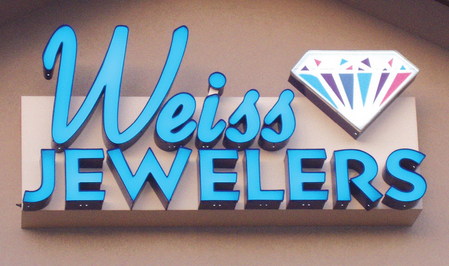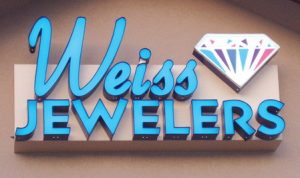Two customers decided to move west. The second-generation businessmen inherited their businesses from their fathers. Both have loyal clientele (including ourselves) and remained loyal to us for many years.
Having been our customer since 1983, Corkran Optical had remained in the same shopping complex for 27 years. However, when Craig Corkran told us he was moving, we weren’t surprised. We knew the shopping complex had been sold, and the new owners planned to demolish his building. The only questions were when and where he would go.
Conversely, when Rich Weiss of Weiss Jewelers called, we were shocked. Having been a mainstay of the downtown area since 1915 (and our customer for 31 years), the deteriorating shopping center had weathered four renovations. We understood the need to follow customers as the town moved west.
Both moved into the same complex, which limited them to wall signs. Both allowed Kent to design the new signs. Both were end stores with three exterior walls, and both shared a wall with a neighboring store.
Weiss knew what he wanted: “Weiss,” a recognizable and trusted name in Greeley, must retain the original font, but “Jewelers” could be bolder and larger to attract new-comers unfamiliar with the name.
Advertisement
Although we knew about the move months before, Kent had merely three weeks to design, fabricate and install the signs. Because the original Weiss storefront bore a neon diamond with chasing lights around it, Kent designed a new, subtler diamond. He modeled his creation on an antique drawing that had been part of a set given to Kent as a present from a diamond wholesaler (these precise drawings had served as guidelines to grade diamonds).
Corkran allowed Kent more artistic freedom, but, because this move was involuntary, his budget wasn’t as flexible. We also were forewarned about this move, but the budget and location were last-minute decisions. Kent retained Corkran’s basic concept (the glasses disguise his name), but created a new logo and then modified it to fit limited space (Corkran decided to share the space with a tenant). Using LEDs in open architecture with transparent, black-cherry plastic, he economically created a halo and a glow.
When Kent completed the projects, we thought Howard Weiss and John Corkran (our original customers) would’ve approved.
Once the jobs were completed, my job – costing – begins. A computer simplifies this undertaking. We track sales, direct expense, overhead and our time (direct and indirect). Then I apply formulae to determine how much we make (or lose) on each job.
The Corkran Optical sign was invoiced at $3,476. Gemini Inc. (Cannon Falls, MN) supplied the 53 x 32-in., acrylic, cutout logo, made to our patterns, for $616.04, including freight. To accommodate the tight schedule, Elk River fabricated the can in our shop. Our scrap materials kept our cost down to $255.
Advertisement
Additional materials included 25 ft. of white GELcore LEDs ($442.75), plus the power supply ($91.43), electrical fittings ($60.74), paint ($38.85) and employee time ($5.87). Our direct expenses, $1,480.68, gave us a $1,955.32 Contribution to Overhead (COH). Kent’s time for design, permitting, installation and collection (from the leasing company Craig had chosen) totaled 16.42 hours.
A $121.52 COH/hr. minus our $48.39 overhead rate equaled a $73.13 costed income, which, at 25% profitability (three noncostable hours for each costable hour), means we made $18.28/hr.
The Weiss job was much larger, more complex and more profitable. Three channel-letter sets (for three sides of the building), including the three diamonds, sold for $12,890.79. DH Wholesale (Ft. Collins, CO) fabricated the entire project for $8,020.84. Kent added vinyl to the diamond to create the faceted appearance and designed the signs. He also installed the job with Elk River’s assistance ($150). The vinyl cost $3.22, plus $3.91 for our employee, Mikal, to weed it.
The direct expenses on this job totaled $8,177.97, leaving a $4,712.82 COH, not as high as the usual retail markup, but quite respectable.
Everything went smoothly. Kent spent only 14 hours designing the sign and the diamond, having first communicated with the customer and DH to clarify the project, and completed the vinyl graphics, permitting and installation. The $4,035.36 net income, after overhead, and $288.24 net/hr. garnered $72.06/ total hour true income (after applying the profitability ratio).
Sometimes you win one. When a job goes this well, a firm bid proves advantageous.
Advertisement
| Job Costing |
Corkran Optical Costs |
Weiss Jewelers Costs |
| Owner's hours |
16.42 |
14 |
| Direct expenses |
$1,480.68 |
$8,197.77 |
| COH |
$1,995.32 |
$4,712.82 |
| OH |
$794.56 |
$677.46 |
| NET |
$1,200.76 |
$4,035.36 |
| Net income/costable hr. |
$73.13 |
$288.24 |
| Income/total hr. |
$18.28 |
$72.06 |


 Photo Gallery1 week ago
Photo Gallery1 week ago
 Ask Signs of the Times2 weeks ago
Ask Signs of the Times2 weeks ago
 Paula Fargo1 week ago
Paula Fargo1 week ago
 Real Deal5 days ago
Real Deal5 days ago
 Photo Gallery1 week ago
Photo Gallery1 week ago
 Women in Signs2 weeks ago
Women in Signs2 weeks ago
 Women in Signs2 weeks ago
Women in Signs2 weeks ago
 Projects5 days ago
Projects5 days ago

















